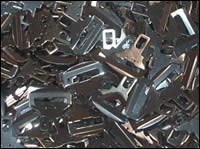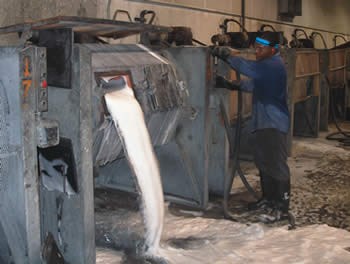Improvements are Never Finished
Lean thinking and an entrepreneurial spirit propel mass finishing job shop
When Jerry Stenger isn’t busy running Cincinnati-based Mechanical Finishing Inc. (MechFin), he likes to work on some side projects. Examples include developing a biodiesel process to power his company’s truck fleet and piecing together a home-grown vision inspection system that will enable 100% inspection of critical parts.
With no experience in mechanical finishing, Stenger launched MechFin in 1992. But he was in business for himself long before that. His previous ventures include a construction and remodeling business and a limousine service. “I’m an entrepreneur,” he says.
MechFin today is a 25-employee company that operates a variety of finishing and cleaning equipment, including tumbling barrels, vibratory bowls and tubs, shot peening and wheel blasting systems, belt sanders, vapor degreasers and ultrasonic cleaning systems. The company can process up to 350,000 lb of steel parts per shift.
Launched in an industrial facility dating to the late-1800s, MechFin moved to a new, 40,000 sq ft building in 2000. The move enabled several operating and environmental improvements, according to Stenger. “When we built the new building, we designed it so we have two separate wastewater collection systems,” he says. “I wanted to try to contain as many of the wet operations as I could in one area of the shop. We were able to contain our wet area in 15,000 sq ft. In our old building, that was 35,000 sq ft.
“One wastewater system collects most of the oil and grease, which we can treat separately from suspended solids. That significantly reduces our wastewater treatment costs, and it also enables us to recycle the water and reuse it,” he explains.
Cellular Layouts
The new building’s layout is partially cellular and partially in functional departments. The arrangement reflects not only the dual wastewater treatment plan but also MechFin’s use of lean manufacturing concepts to reduce throughput time on some high-volume jobs.
“We used a consulting firm to do lean training for the entire company,” Stenger recalls. “Then we asked people to volunteer to sign up to take part in a lean event. We had so many volunteers we had to have a second event. They’ve proven to be very beneficial, and they’ve enabled us to reduce costs enough that we can share the reductions with our customers.”
One job that came under scrutiny was tumbling of a steel seat belt buckle component. “It’s a very high-volume, low-margin job. If you make a mistake, you can easily not be profitable with it,” Stenger says.
The stamped steel buckles arrive at MechFin dirty, and may or may not be heat treated. Buckles are taken straight to horizontal barrels for tumbling, which removes any burrs and improves their surface finish and cleanliness. The tumbling media used is either a natural quartz stone or ceramic. Cycle times vary depending on incoming part condition and processing conditions. Processed buckles are shipped for zinc or nickel-chrome plating.
MechFin has enough capacity in its horizontal barrel tumbling operation to process 100,000 lb of buckles per day. “Other shops are trying different ways of tumbling the parts—high-energy barrels, centrifugal disk machines, vibratory finishing—but none of them gives the same finish as a tumbling barrel,” Stenger says.
Employees formulate custom compounds for cut and burnishing cycles, using different water levels to achieve the desired finish on a variety of parts. A visual check assures that the parts are deburred and have the same appearance as previous batches. Buckles are then separated from the media and sent to the next processing step.
More Cells
Other jobs at MechFin have also benefited from application of lean principles and conversion to a cellular manufacturing concept. One is a stainless steel component for a refrigerator ice crusher that requires cleaning, passivation, drying and packaging. “We looked into the cost for us to do that and came up with a process that involved development of a lean cell,” Stenger recalls. “That enabled us to be competitive price-wise and meet the part specifications.”
Stenger was skeptical that the lean team’s idea would work. “But I was very pleasantly surprised and impressed when they put it together,” he says. “It worked, and it works continuously, and it’s proven to be one of those cells that hits the bid requirements repeatably.
“We were able to cut the amount of travel through the shop by 300% while reassigning one worker to another area of the shop,” Stenger explains. “Throughput increased from where we were losing money on the job to where it was profitable. Floor space saving was 35%.”
In yet another case, a family of parts required a multi-step process consisting of belt sanding followed by either vibratory finishing or tumbling. Parts would be processed through MechFin’s three-head belt sander, then go into a container to await the next process step.
“A group in one of the lean events looked at how they could consolidate secondary processing in one machine and using one kind of media,” Stenger says. “We relocated some machines, we bought some conveyors, and were able to reduce days of production time to three hours.
“It was mainly a matter of allowing the team to find the media that worked on all the parts,” he continues. “They did sampling to be sure we were still meeting part specifications. At that point it became a matter of relocating the equipment where it made sense and writing standard procedures. We timed each step in the operation, and we reduced travel through the shop by more than 700% on this one job.”
Computerized “Cookbook”
All jobs at MechFin—even those that have been formally quoted but have never actually run on the shop floor—have a “recipe” that resides on the company’s computer network. “Every job we do is in the computer system,” Stenger says. Some parts run under the same process ID, so we may have 2,000 different recipes. Out of those, maybe 200 are active every day or every other day. The rest might be once or twice a year. Regardless, the recipe for that part number is in the system.”
Besides processing recipes, the package provides full accounting, quoting, order tracking and other business capabilities. “We bought a system that was originally designed for platers,” Stenger explains. The developers modified it for mechanical finishing, and they are good about upgrading it on a regular basis and tailoring it to our needs.”
The computer communication systems also enables MechFin to perform inspection, record-keeping, and logistical services that Stenger believes give his company an edge over the competition. “We do all kinds of dimensional and hardness testing, and other inspection processes,” Stenger says. “We remote connect into our customer’s software and enter quality results, shipping data, and other information. We maintain accurate inventories, sometimes large inventories, for customers. We have a proven history of reliability in terms of processing, inspection, packaging and shipping parts, and we do it right on our customer’s software. It’s been very effective.
“Those capabilities allow us to quote finishing a part and then sending it directly to our customer’s customer. If customers take their production cost minus secondary processing costs here, and it’s less than their selling price, they usually take advantage of our company being able to incorporate all these services. That’s profit they realize with no effort and time spent,” he says.
Continuous Improvement
MechFin takes the lean concept of continuous improvement seriously, and plans more lean events in the coming year. “A couple of the lean manufacturing events last year went way beyond my expectations,” Stenger says. “We are constantly making changes and improvements.”
For example, in an effort to provide repeatable 100% inspection of critical parts, including seat belt buckles, the company is designing and building a home-grown vision inspection system. “They’ll be used for both dimensional inspection and appearance,” Stenger says, pointing out two small holes in the buckle where media can sometimes lodge. “There’s no way I could’ve gone out and hired someone to build a system for us, so we started piecing together different kinds of equipment to put the systems we wanted in place.”
A prototype conveyor system is complete, and experiments in the MechFin’s quality lab are aimed at finding the right color of conveyor belt to maximize contrast through the camera. “We’ve also developed an indexing table that will tie in to that same machine for a different part family,” Stenger says.
He also credits membership in an industry association with helping MechFin find ways to be more efficient and tackle new projects. “Being a member of the Mass Finishing Job Shops Association [MFJSA] has opened my eyes to so many different things,” Stenger says. “This business is primarily geographic, so we’re not really competitors. By talking with other members, you can see so many ways of doing things.”
An example is MechFin’s entry into belt sanding. “I knew a lot of guys in the association who do that, so I could pick up the phone and pick the brains of some of those people and get a lot of first-hand information about what works and what doesn’t.
“Sometimes just seeing that someone else is doing it can make the difference. When we had waste discharge issues with the seat belt buckle process, a shop in California was already treating and recycling their wastewater. I went out to visit and got a really good idea of what was involved.”
This year’s MFJSA president, Stenger has some final advice for other shop owners. “If you’re in this business, I don’t believe you can be successful alone. If you’re doing that and you think you’re doing well, you have to understand that you can do better. You can do that by joining the MFJSA,” he concludes.
Read Next
Education Bringing Cleaning to Machining
Debuting new speakers and cleaning technology content during this half-day workshop co-located with IMTS 2024.
Read MoreEpisode 45: An Interview with Chandler Mancuso, MacDermid Envio Solutions
Chandler Mancuso, technical director with MacDermid Envio discusses updating your wastewater treatment system and implementing materials recycling solutions to increase efficiencies, control costs and reduce environmental impact.
Read MoreA ‘Clean’ Agenda Offers Unique Presentations in Chicago
The 2024 Parts Cleaning Conference, co-located with the International Manufacturing Technology Show, includes presentations by several speakers who are new to the conference and topics that have not been covered in past editions of this event.
Read More















.jpg;maxWidth=300;quality=90)






